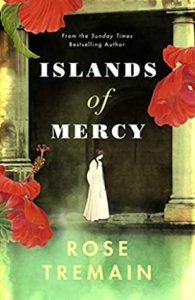ISLANDS OF MERCY | ROSE TREMAIN | 2020
This is what I would call an ensemble piece: numerous characters with their own stories and their own chapters. Two stories are loosely intertwined, one set in Bath England and the other in Borneo in 1865. This is the era of Dickens but there is no hint of his longwinded descriptions of squalor and penury rather this is a modern interpretation of the times and includes both lesbian and homosexual relationships.
Jane Adeane lives in Bath and has a formidable reputation as a nurse with almost magical powers to heal. She works with her father, a doctor Sir William Adean and Dr Valentine Ross who is in love with her. However, Jane is not in love with the doctor and is drawn into an erotic relationship with a friend of her aunt when he visits her in London. It’s Jane’s unconventionality that is the star of the story. She is majestic, and strong and witty, and determined to follow a life of meaning.
In Borneo, rich Sir Ralph Savage is a so-called Rajah who is in a passionate relationship with his Malay servant Leon. Valentine Ross’s brother, a visiting naturalist Edmund Ross, is drawn into the Rajah’s orbit and there lies the connection of the two stories.
There’s enough reference to the customs of the era without it becoming a pastiche of Victorian romance with overtones of strict formalism of relationships. These are real people with real passions and face hardships with emotional turmoil in a realistic fashion. No fits of the vapours of euphemisms here.
What I particularly enjoyed about Jane’s story was the build-up to how a relationship with Valentine Ross might actually eventuate. I was three-quarters way through the book and still had no idea what would happen. But when it did I was truly surprised at how well and realistically it was written. The Borneo story wasn’t as enthralling but was still an interesting tale. Sir Ralph’s foolishness is easily pictured from his description and the cunning of Leon is an insight into manipulation.
Of course there are other characters involved, not just in supporting roles but interesting and touching people who, like Jane and Sir Ralph, Edmund and Valentine are all seem to be running away or running towards something momentous in their lives. At times it’s hard to know which character deserves our sympathy such are the twists and turns and the value of the many perspectives. As the author writes: “… we all risk being defeated by some small weakness in us that we cannot control. And then that is the end of us.”
The author’s research throughout is faultless but never intrusive, and the narrative exciting and satisfying and so credible. The plot is, at times, surprising and yet gripping with the individual tales entwined impeccably.

